 |
|


25th January 2011
CERVIA's crew win an award from the Ramsgate Society!
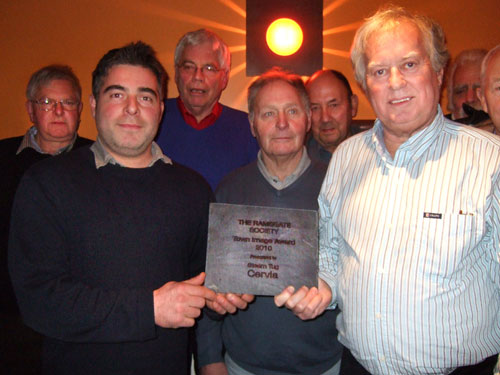
Richard Albanese, Mike Houckham and just some the many volunteers involved in
the steam tug Cervia's restoration, proudly showing their award.
The Ramsgate Society, a local civic and historical group dedicated to the care and improvement of historic Ramsgate, have presented an award to the volunteer restorers of steam tug Cervia.
Cervia's many volunteers assembled to recieve the 'Town Image Award' just before Christmas. This award was in recognition of their hard work over the past 18 months, hard work which has already brought some considerable visual improvment to the steam tug and thereby to the whole Royal Harbour area, of which Cervia is such a well known feature.
Despite the lack of news being posted here on the Steam Museum website, much work has gone on in the background and the internal restoration aboard Cervia has continued apace over the winter. Considerable work has been done renovating the boiler room and forward accomodation areas. Further work will continue on the exterior of Cervia during the spring and summer of 2011, with bigger plans afoot that she that she can, eventually, be made fully sea worthy.
SMT trustees have been in discussions with the local authority Thanet District Council over the future of Ramsgate Maritime Museum over the last 2 years. The museum re-opened for the summer of 2009 under the control of The Steam Museum Trust, but detailed negotiations with TDC unexpectedly stalled in the autumn of that year. As a result, the museum was closed during 2010, a great loss to the town and to its many seasonal visitors. Cervia is moored alongside the closed buildings and has been open to the public, attracting good crowds during the summer. A change of direction within the local authority resulted in a resumption of talks with SMT trustees and a 25 year lease of the Clock House and dry dock has now been approved by the TDC 'cabinet'. It is now expected that the lease will be in place during the next 1-2 months, enabling the Ramsgate Museum to re-open its doors for the coming season. Watch this space...
PREVIOUS NEWS
|
7th December 2009
CERVIA's restoration continues apace...
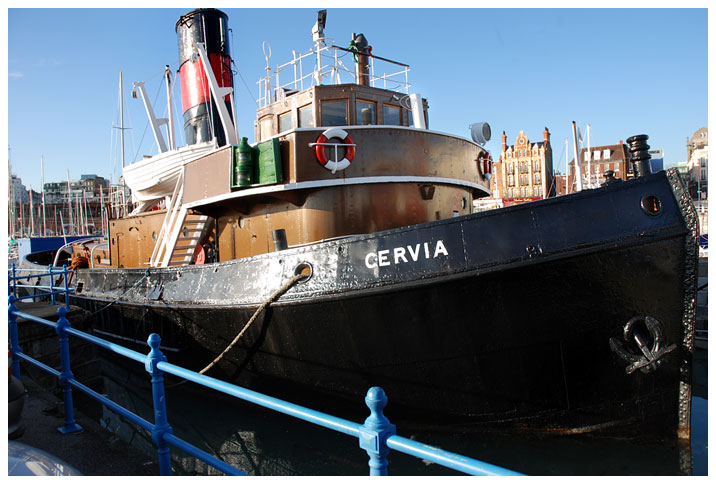
The newly repainted steam tug CERVIA gleaming in the winter sun at Ramsgate.
As the photos show, the past 5 months of hard graft by a team of volunteers led by Richard Albanese has transformed Cervia, and she is beginning to look her old self again.
New paint now covers most of her exterior, following much work chipping and hammering away layers rust from the hull, decks and superstructure, the result of many years of neglect. The tug is now closed to museum visitors for the winter, so some of the heavier work can be carried out. The engine room is also beginning to look rather good again, as the photo below reveals... For comparison you can take a look at the photos from our previous news in July to see how Cervia was before this work began.
However, the essential and very expensive work to slip the vessel and survey the hull plating is currently on hold, awaiting Thanet District Council's resolution as to the future the whole of Ramsgate's Harbour area, which includes the Museum building and dry dock. Unfortunately, this also means that our many planned events for the museum and harbour will have to be held back for the time being.
In the meantime, the museum remains open to visitors and work continues aboard CERVIA, with attention turning towards the boiler room and accomodation areas.
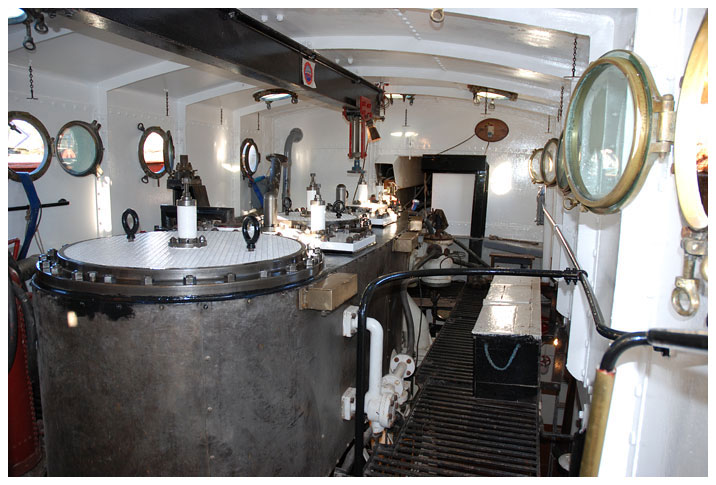
The view into the engine room casing, showing the repainted ceiling and cylinder tops.
|
PREVIOUS NEWS
|
18th August 2009
Boiler for CERVIA
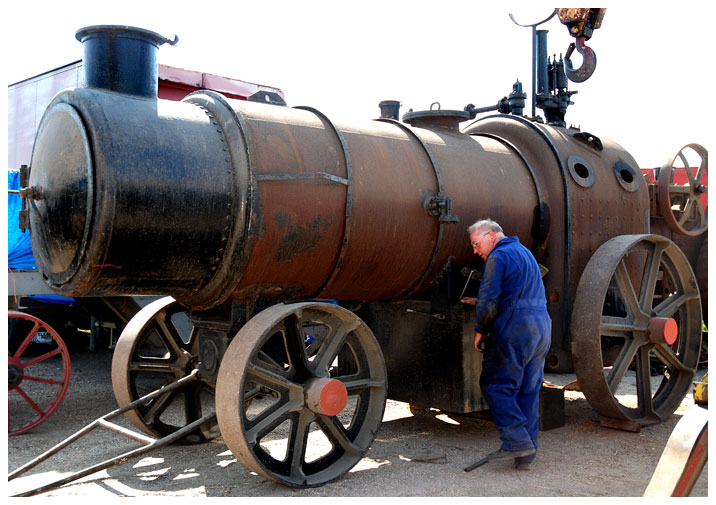
The huge portable dockyard boiler just arrived and being prepared to power CERVIA.
It is hoped to be possible to demonstrate CERVIA's 1,000 H.P. main engine (and attendant machinery) running under steam in the very near future.
To this end, the Steam Museum Trust recently approached the Historic Dockyard, Chatham to investigate the feasability of using one of the ex Royal Navy 'donkey' boilers to provide the huge quantities of steam needed to operate CERVIA. The Royal Navy once used these large, wheeled boilers to provide steam to capital ships when moored up. Several of these boilers survive in the Chatham Dockyard and, following discussions between the 2 organisations, it has been agreed to transfer the equipment to the Steam Museum Trust.
It is hoped that work can start on putting the 'donkey' boiler into operating condition during next week, with the hope of getting the tug's engines running again soon... Please keep an eye on this website, or on the Ramsgate Museum's noticeboard for an update.
|
PREVIOUS NEWS
|
17th August 2009
Job Training at Ramsgate Museum
The Steam Museum Trust are pleased to announce that they are part of a successful bid by "Thanet Works" to provide 5 job training places at the Ramsgate Museum, for young people, commencing in September this year.
Part of a central government £1 Billon jobs fund to help create 150,000 new places nationally, the local scheme is administered by Thanet District Council. Michael Cates, secretary to the SMT, has worked closey with Thanet District Council over the successful application and everyone at the museum looks forward to welcoming the first 5 trainees next month. It is expected that training onboard the tug CERVIA can include: mechanical engineering, steel fabrication, electrical installation, shipwrighting, metal coating and other marine crafts.
|
PREVIOUS NEWS
|
17th August 2009
Volunteers to help restore CERVIA...
Following a campaign spearheaded by the Isle of Thanet Gazette newspaper, lots of volunteers have come forward to assist in the restoration of CERVIA. It has been immensley pleasing that so many members of the public feel very strongly that the tug should be properly preserved for the future, and that they are willing to offer their time and skills to the enormous project.
Numbers of volunteers working on board by Monday 17th August have now reached a total of 9 people, all working under the direction of Richard Albanese. The tug is a source of furious activity and, already, very significant visible progress has been made. The next big goal, after the summer visitor season ends in late September, has to be the planned visit to the nearby Ramsgate Slipways, for essential underwater hull surveys and repairs...
|
PREVIOUS NEWS
|
9th August 2009
CERVIA Re-Opens to the public.
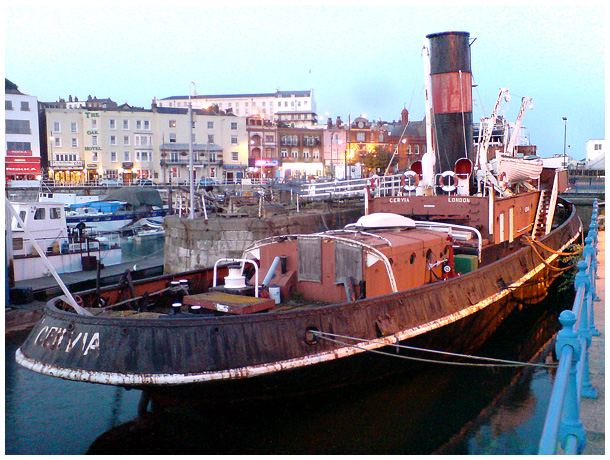
Steam Tug CERVIA at Ramsgate Royal Harbour
Events are now moving fast at Ramsgate. As a result of the dedicated work put in by Richard Albernese, John Vineer and their enthusiastic 5 man team, it was possible to re-open steam tug CERVIA to the public yesterday, 8th August.
Having been closed to the public since 2003, CERVIA will now be accessible for viewing 7 days a week, from 10.00 am to 5.00 pm. Whilst restoration work has only been in progress for 4 weeks, both the interior and the exterior of the vessel can be inspected, including the wheelhouse, the Captain and crew's accomodation, and the enormous 1,000 H.P. triple expansion steam engine and boiler. Admission is without charge to museum visitors - come and see first hand how an important slice of Britain's and Ramsgate's maritime history is slowly coming to life in the Royal Harbour...
|
PREVIOUS NEWS
|
7th August 2009
CERVIA to be Re-Opened to the public soon...!
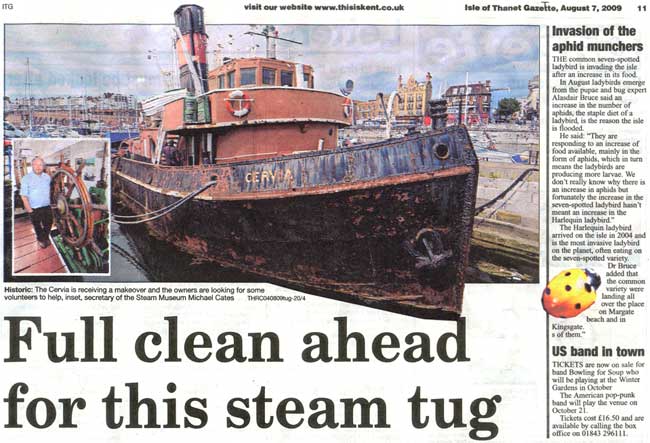
Click above to read the full news article from the Thanet Gazette newspaper, 7th August 2009.
As the above from the Thanet Gazette reports, all hands are on deck to make the steam tug CERVIA safe for visitors once again. With the Ramsgate Museum now open a full 7 days a week, work is racing ahead and we hope very soon to able to allow the public on board for tours... More soon...
(There is, of course, a great deal of long-term restoration to follow over the next year or two, and we encourage those interested in volunteering to come and visit us at Ramsgate Harbour.)
|
PREVIOUS NEWS
|
14th July 2009
Work begins on CERVIA!
Work began today on the restoration of the steam tug Cervia, which we hope to re-open to public access as part of the museum in the near future...
The full restoration of the tug (information on her can be found on this website) will take some 2 years and we encourage visitors and volunteers to visit CERVIA at Ramsgate Harbour.
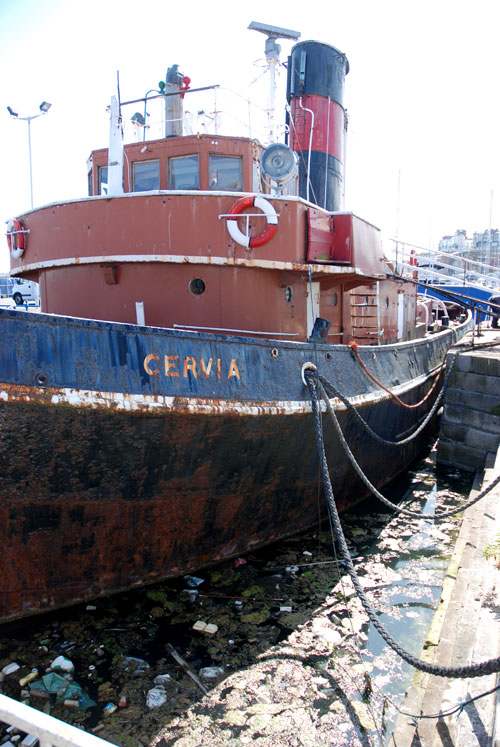
Steam Tug CERVIA at her berth in Ramsgate on 14th July.
|
|

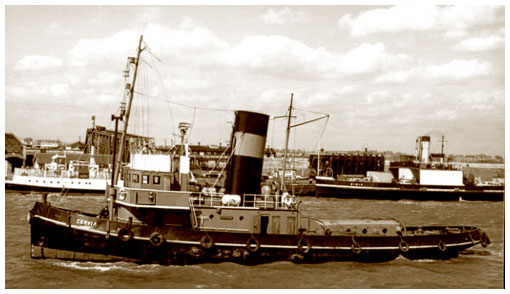
The largest 'object' in the collection is the Steam Tug "CERVIA", which can be seen at the Ramsgate Museum. Weighing in at over 350 tons, and powered by a massive 1,000 HP triple expansion engine, Cervia is a rare survivor from the pinnacle of steam ship development. Cervia is the last sea-going steam tug to survive in UK waters, and she was also the last to work commercially!
She is described by Martyn Heighton, Head of the National Historic Ships Unit, as " a remarkably complete and important ship, still in her original configuration". This unit, which is the Maritime equivalent of English Heritage, is based at the National Maritime Museum, Greenwich and maintains the National Historic Vessels Register. Cervia has been seen to be sufficiently important to Britains maritime history as to be granted Certificate No. 5. |
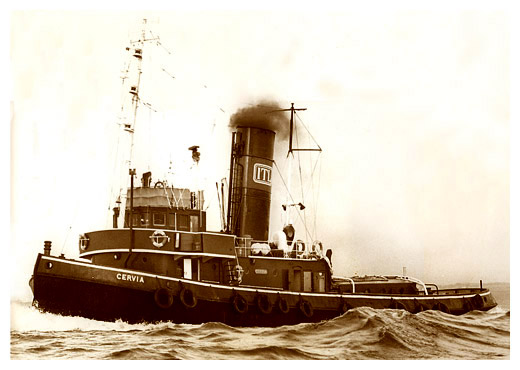
S.T. CERVIA when in service with International Towing Ltd.
The "Empire" Ships ~ Wartime Design and Build.
Although laid down in the closing phases of the Second World War, Cervia was closely modelled on the "FOREMOST", a much older, 1928 design of steam tug. This built-in obsolescence might seem strange at first, until you consider the circumstances that led to Cervia, and her sister tugs, being ordered by the Government.
During the early years of the war Britain was very much an isolated nation, highly dependant on shipping for her vital supplies of food, raw materials and equipment. And so a bitter struggle ensued on the seas around Britain - a fight between convoys of mechant ships laden with these important supplies and packs of German U-Boats hunting them down. Eventually the Royal Navy gained the advantage with The Battle of The Atlantic, and so more and more of these merchant vessels arrived in the ports of 'Fortress Britain'. This success, however, revealed a shortcoming. At that time all large ships relied on tugs to dock and undock them and, due to a combination of war losses and the sudden increased demand, there were simply not enough tugs to do the work. The solution to this was a rapid government building programme and, so as to avoid delays with new designs, a committee of tug owners and representative from the Admiralty chose from the 'cream' of prewar tug designs (those best suited to the tasks at hand) to be 'copied' and put into immediate action.
This had lots of benefits - apart from a rapid build time (with re-design kept to a minimum), the ships could be operated by older, more experienced civilian crews - often those past retirement age. They could be built with home-grown materials and equipment, and, if necessary, their boilers could also be fuelled by coal, so freeing up some of the scarce oil supplies for navy warships, etc.
The larger classes of these new tugs, including the "Foremost" class, were designed to be armed and to have sufficient range to be able to escort and assist the convoys in the Western Approaches and around the vital supply route to Murmansk. But, as the tide of war turned, supplies (including fuel oil) became secure. Plans now turned to invading German occupied Europe, and so a different problem presented itself.
With 'D Day', the allies needed to be able to land vast amounts of men and equipment on the beaches of Normandy, for which there was an unprecedented need for tugs to tow the multitude of Naval and supply ships, barges, landing craft and the innovative, top secret "Mulberry Harbours", which made the invasion of Normandy possible.
"EMPIRE RAYMOND", which is Cervia's original, official name, was part of the revised building programme ordered for the invasion, though the defeat of Germany meant that she was not actually completed until after the end of the war. Her 'invasion design' features included an armoured wheelhouse and gun emplacements. Cervia was supplied with oil burners for her boiler (but again she is designed to be able rapidly reverted to coal firing).
All of these war time government ordered merchant vessels were named with the "EMPIRE" prefix - the equivalent of the American "LIBERTY SHIP" programme - Cervia is believed to be the last surviving EMPIRE SHIP in the UK!

S.T. CERVIA in her early days working on the river Thames. |
William Waktins Ltd ~ A long tradition in the towing business.
John Rogers Watkins founded one of the world's first towing companies in 1833, and his 14 year old son William, whose name the company was to trade under for over a century, worked alongside his father on their first tug "MONARCH". To this tug fell the duty of towing a famous veteran of Trafalgar to the breakers in 1838. This scene was immortalised in J.M.W. Turner's "The Fighting Temeraire, tugged to her last berth to be broken up", which was recently voted the UK's 'Favourite Work of Art'. They also undertook the world-beating towage of "Cleopatra's Needle" all the way from Egypt to London.
Just over 100 years later William Watkins Ltd. acquired what was destined to be the last survivor of that long tradition. "EMPIRE RAYMOND" (Cervia) was purchased from the Ministry of War Transport in 1946, for £36,000 - this funded by compensation for vessels lost on War service - vessels such as "NAPIA" and "MURIA" which were sunk by mines near Ramsgate in 1939/40.
Empire Raymond was shortly employed with other tugs in salvaging the mighty Cunard liner the "QUEEN ELIZABETH" and, in 1947, she was renamed Cervia - after the Italian Adriatic resort where the Watkins family kept a holiday villa. The name was previously allocated to an earlier Watkins tug which took part in the evacuation of Dunkirk.
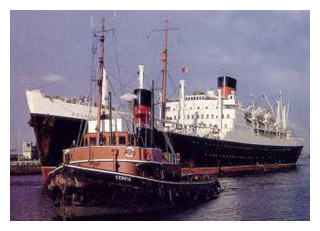
S.T. CERVIA Towing "RUAHINE"
The main tasks for S.T. Cervia were towage between ports in the UK and the continent and, as a salvage tug, occasional operations on the treacherous Goodwin Sands off the Kent coast. For this rescue and salvage work she was often based at Ramsgate port, beginning an association with Ramsgate which has continued for almost 60 years! Like "MONARCH" before her, she towed sailing ships including "PAMIR" and the "BOUNTY" - perhaps Ramsgate's best loved attraction in the post war years. Cervia was regularly maintained at the harbour, along with the whole Watkins fleet, by the extensive workshops and slipways of Claxtons Ltd. (a subsidiary of Watkins). In 1950 William Watkins Ltd merged with other companies to form Ship Towage (London) Ltd. and it was under that company's flag that a terrible tragedy overtook Cervia.
In October 1954, Cervia was undocking the P&O liner "ARCADIA" at Tilbury. To avoid 'collision' with another liner, Arcadia went full ahead and the resulting wash caused Cervia to be dragged over (girted), capsize and sink. Despite their valiant efforts to release the towing hawser Captain Russell, MBE and his four crew died in the accident.
Fortunately, Cervia survived and she was raised from the Thames riverbed within days. She was brought to Ramsgate for a refit, before being returned to service. An original news reel of the aftermath of the disaster can be seen at British Pathe News.Com Click here 
CERVIA at International Towing Ltd in the 1970's.
CERVIA returned to work on the Thames and, in 1969, her owners merged with W.H.J. Alexander & Company Ltd. to form the London Tug Company. This new company, like Ship Towage Ltd before them, had a long standing policy to phase out steam tugs in favour of more modern diesel vessels. The first such tug they built was "MOORCOCK", soon followed by "DHULIA" and "SUN 27", etc. By 1971, the writing was on the wall for the remaining steam tugs and Cervia was laid up at Sheerness awaiting a buyer, or, more probably, a trip to the breakers yard.
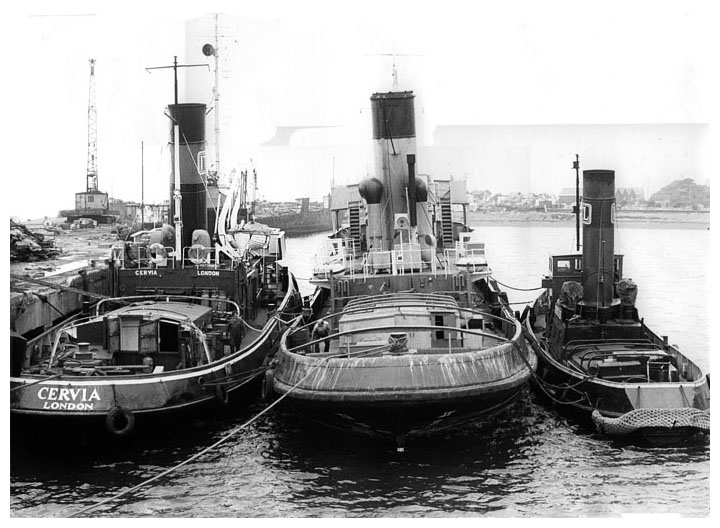
S.T. CERVIA, along two other tugs of the ITL fleet GOLIATH and HERCULES, assisted with the final towage of the huge naval ship HMS Ark Royal, which was cut up at
Cairn Ryan, Scotland in 1975.
It was at this stage that events took an unexpected turn, because Michael List Brain stepped in. Michael was half way through a marathon trip around the world in a steam wagon and, during the Australian leg of his tour, he had met and befriended a (rather eccentric) man called Warwick Turner. Warwick lived on a steam tug in Sydney Harbour and was intent on saving as many other steam tugs in the southern hemisphere as possible. Warwick's enthusiasm for tugs was very infectous. To the point that Michael joined forces with him during his time in Australia and almost ended up becoming the expatriot owner of "S.T. HIMMA" - a very large, 'Super Stella' class empire tug. Fortunately, sanity prevailed at the last moment - Michael realised the impracticality of ownership from 12,000 miles away and the plan was dropped.
It was Michael's return to London in January of 1972, to drum up vital sponsorship in order to complete his round-the-world trip, that led to an impromtu meeting with the charming and understanding members of the Board of London Tugs. Cervia was available and the board agreed to her sale "as is, where lies", for then princely sum of £3,500. This was to be paid off in installments from earnings (hopefully) to be made whilst driving the Foden steam wagon "Britannia" across the USA.
Having achieved his goal of being the first (and only) person mad enough to drive a steam engine right around the world, and on returning triumphantly to England in April 1973, Michael found that Cervia was awaiting her new owner, safely laid up in Poplar Docks, London. A short refit and a lot of learning saw Cervia back in steam that summer, with several trips taken on the Medway river both for pleasure and for familiarisation. It was hoped, at this stage, to develop a new organisation called "The Medway Maritime Museum" - the brainchild of one of Britains most senior ship preservationists, Martin Stevens. A rapid period of aquisition follwed, with vessels of all types being either earmarked or purchased, including "THE MEDWAY QUEEN", various "TID" tugs, the "BIDDICK", "164" and "SOLWAY", etc.
Unfortunately the Medway Council proved to be unable to provide sufficient funding for the project, despite backing another even more ambitous but unsucessful project to buy the famous sailing ship "PEKING", then redundant as the training ship "ARETHUSA". The "PEKING" disappeared off to New York and the proposed site of the new museum was developed as a headquarters for Lloyds of London.
Never being one to admit defeat, Martin Stevens persevered with his plans in the long term and now, some 30 years later, the Medway Maritime Trust is the custodian of several steam ships in the area. But in 1974 the original museum project still looked very precarious, having neither premises nor any money but still faced with the contsant and expensive task of maintaining steam ships. One day, however, a chance remark by a passing boatman sowed the seed for an obvious solution to the museum's income problem - why not return the tug Cervia to her proper role, and put her back to work in the towage business? As neither Martin nor Michael had any tangible marine experience, the thought of setting sail in an old 1,000 HP steam tug was a bit daunting..!
Fortunately, at this time the North Sea was just begging to open up for oil and gas exploration and the Medway based construction firm of Howard Doris suddenly needed all manner of craft to assist with oil rig construction, etc. Michael and Martin saw their opportunity and secured an initial contract to tow a crane barge to the Humber in late November of 1974, which led to a very rapid re-equipping of Ceriva. This first contract was completed surprisingly smoothly, but a complete lack of understanding as to the economics of marine towage meant that the nett profit from this first voyage with Cervia was the princely sum of £7.00!
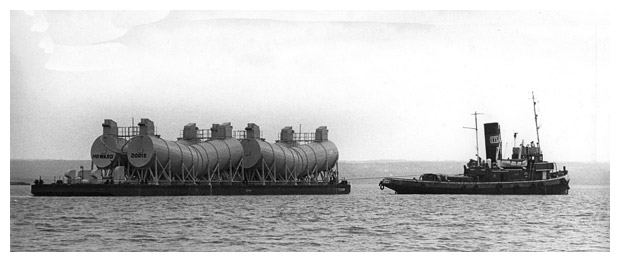
S.T. CERVIA towing a large cement batching plant to Kyle, Scotland for
concrete oil rig construction in 1975.
A determination (with some misgivings) to adopt a more business-like approach to these towage jobs meant that Cervia, with a professional crew, spent the whole of 1975 carrying out a very successful series of coastal towages and short-term charters, all around the UK coast. In fact, Cervia never stopped working for some 12 months, save for a 36 hour period of essential boiler cleaning. As the demand for towage seemed to be on the increase, it was decided to form a proper company - and so was born International Towing Ltd. (or ITL).

S.T. CERVIA with a jack-up drilling rig in the North Sea, June 1976.
Cervia could not keep up with the demand on her own, and so Michael began to search for other vessels to join the ITL fleet - adding other steam tugs such as "HERCULES", "HERO" and "GOLIATH".
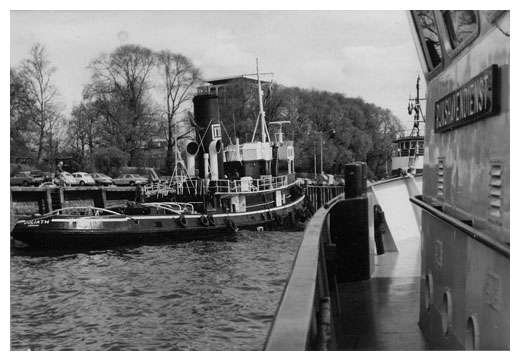
The biggest of ITL's steam tugs 'GOLIATH' at Rotterdam
and waiting to tow to Yemen in 1977.
ITL chose Ramsgate as their home port from January 1977 and, like Watkins before them, refits to Cervia, and other vessels in ITL's growing steam tug fleet, brought about a resurgence of commercial ship repairing, and this giving a major boost to the local economy for many years. Ramsgate Harbour's main slipway, which had seen little use since the early 1960's, was recomissioned for a major refit of the tug in 1977, with the enthusiastic support of Thanet District Council. The special 'cod' blocks used in slipping Cervia can still be seen alongside the slipway today.
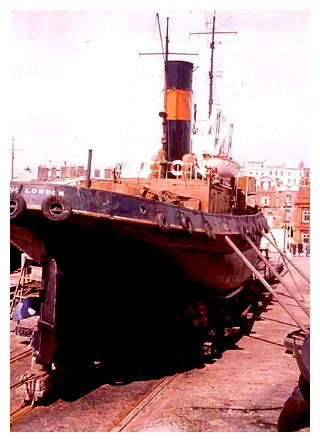
S.T. Cervia undergoing some repairs on Morton's Patent Slipway,
at Ramsgate Royal Harbour, January 1977.
By the follwowing year ITL was a well-established name and the steam tugs were very busy indeed! Cervia and her sisters found a mixutre of jobs both in the North Sea and in coastal towage, with the latter often involving some notable steam ships and breakers. It was quite a transition, however, from museum aspirations to becoming a fully fledged commercial operation, particularly in the very hard-nosed world of marine towage, and so the partners decided, by the beginning of 1977, to seperate the two operations. Empire tugs Cervia and Goliath remained with ITL, whilst the paddle tug "Hero" ("John H. Amos") and "Hercules" ("TID 164") regained their former position with the Medway Maritime Trust, under the guidance of Martin Stevens.
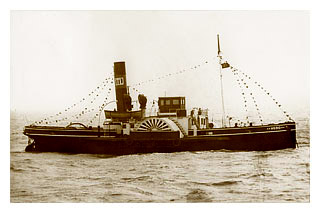 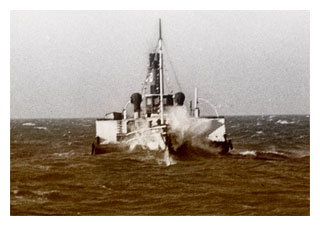
S.T. "HERO" (paddle steamer John H. Amos) in her ITL days being towed from
the Tees to the Medway. Photos by Martin Stevens.
Thanks to Cervia, ITL continued to grow and the business rapidly expanded into an international operation. As customers demands increased, ITL added modern deep sea diesel powered tugs to the fleet from 1978. By the time ITL was sold off to the far east at the end of the 1980's, it had grown to include the 2 most powerful tugs in the northern hemishpere.
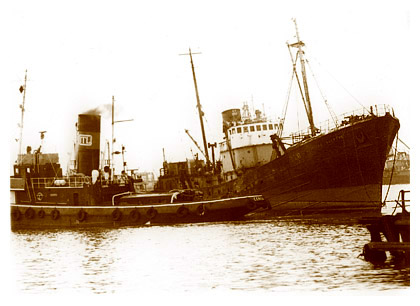
S.T. CERVIA preparing to tow 2 redundant Icelandic trawlers from Grimsby in 1978.
Even when she was built, Cervia was an obsolete vessel in design terms, but it is a testament to British shipbuilding and engineering that she carried on working until 1983. Her last job was as port tug to the new cross-channel ferry service at Ramsgate, providing assistance to ferries in adverse weather conditions. Due to economic difficulties the ferry service was intermittent and Cervia was eventually 'mothballed' alongside the East Pier at Ramsgate Royal Harbour, this following a final re-fit for a towage contract in Norway, which never materialised. Some other notable engagements during this time were charters to various film companies, including the BBC. Cervia featured in "Rogue Male" starring Peter 'O' Toole and, as the "S.S. Greasy", in the Monty Python film "The Curse Of The Claw" with Michael Palin! |
CERVIA at the Maritime Museum, Ramsgate.
In July of 1985 Thanet District Council's Harbour Master and his deputy, who had considerable experience of historic ships, negotiated a loan of the tug and arranged for Cervia to be brought into the shelter of the inner harbour where she was moored in part of John Smeaton's Historic Dry Dock. Later that month she was placed in the care of Ramsgate Maritime Museum, run by the East Kent Maritime Trust.
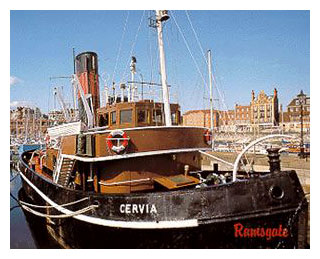 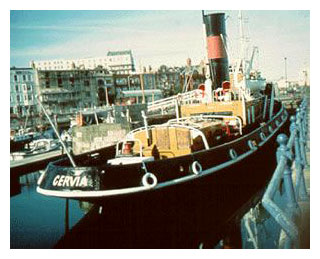
Cervia is moored in part of Smeaton's Dry Dock at Ramsgate Royal Harbour.
The EKMT Trust was granted a Manpower Services Commission project to restore Cervia, this managed and funded by a Thanet District Council agency. Early work included repainting in the original working colours of William Watkins Ltd., the fitting of a new mast and the refurbishment of her accommodation so as to provide and educational display space for the Museum.
In 1986 the project was visited by HRH Queen Elizabeth the Queen Mother.
The ship quickly became a favourite of visitors to the Museum, especially for school groups, and she became the centre of attraction at Maritime Museum events in Ramsgate such as the popular Children's Open Days and the successful series of Ships Open Days and other maritime festivals.
To mark her 50th birthday EKMT commissioned specialist steam engineer John Veneer to restore her 1000 HP engine to full working order. The restoration was described by visiting steam ship experts as "by far the best they had seen" and the engine was run for special events, with steam supplied from a shore-side boiler.
She became the nucleus of an innovative joint EKMT/T13C 'Historic Harbour', joined by other vessels from the Museum's collection and privately owned classic boats.
In that time she has inspired countless models - from tiny miniatures, showing every rivet in precise detail, up to 3 metre long, live steam powered radio controlled models.
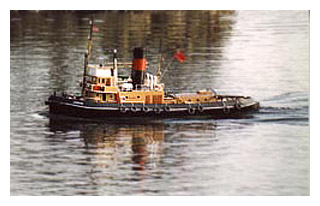 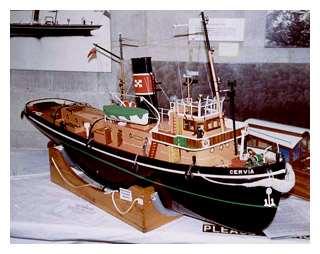
2 different radio-controlled scale models of steam tug Cervia.
|
...S.T. CERVIA ~ A Future?
In 2005 the EKMT commissioned a report on the way forward for two major heritage assets in its care - namely Smeaton's Dry Dock and the steam tug "Cervia". The report's conclusions were that an achievable joint restoration project should be put together with a possibility of securing funding from a number of sources including the Heritage Lottery Fund, the European Regional Development Fund, other E.U. grants and private sources. This would be of benefit not only to the ship and the dock but also serve to revitalise the Ramsgate Maritime Museum and increase its visitor numbers. The Ramsgate Maritime Museum's information leaflet on Cervia ends with a wish that the tug can continue her long association with (the Museum) and Ramsgate.
However, due to a restructuring and a redrawing of priorities, the EKMT was unable to take these recommendations further and the project was shelved. The Trust also found it impossible to continue carrying out essential maintenance and now Cervia may shortly be at risk unless an alternative conservation plan can be put in place.
The Steam Museum Trust encourages the East Kent Maritime Trust initiative to restore the tug and dock and would support a resumption of the EKMT plan. However, in the light of the difficulties facing EKMT, the Steam Museum Trust is developing a 'stand-alone' restoration project for the tug (The important Dry Dock is beyond SMT's remit) and is seeking partners, advice, practical help, funding and other support to help save this unique survivor from the age of steam.
|
A 'Quick Reference' fact file:
Built 1945-6 by Alexander Hall and Co. Ltd., Aberdeen. YN709. Steel Screw Tug. Length 105.2 Ft B 27.1 Ft D 11.7 Ft 233 Grt. 900ihp 3 Cyl TE oil fired steam engine by builder. Official No.180997. Call sign GDPM.
21-1-1946 Launched as Empire Raymond for Ministry of War Transport. Foremost class. 30-4-1946 completed and handed over to Townsend Bros. Ferries Ltd. for onward delivery.
12-1946 Sold to William Watkins Ltd. for £36,000, 1947 renamed Cervia. 1-2-1950 Transferred to Ship Towage [London) Ltd.
26-10-1954 Capsized and sank whilst assisting P & 0 liner Arcadia at Tilbury. The Skipper and four crew were drowned. 28-10-1954 Raised and towed to Ramsgate for repairs.
27-1-1969 Transferred to London Tugs Limited.
1971 Sold for preservation at Medway Maritime Museum.
1973 returned to towing with International Towing Ltd., UK/Europe coastal towage and North Sea oil rig moves. Last in service as port tug at Ramsgate.
July 1985 loaned to East Kent Maritime Trust's Ramsgate Maritime Museum, for preservation. |
|

Site design by 
|







